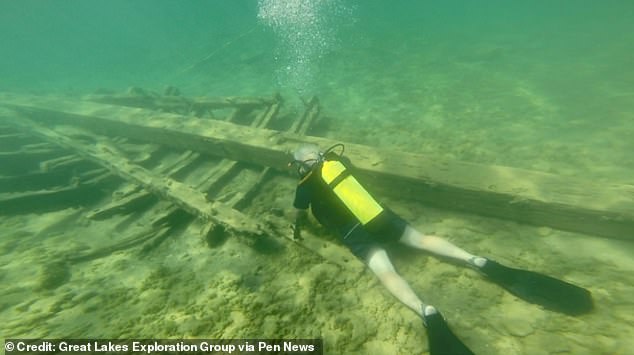A Michigan shipwreck hunter claims to have discovered the remains of a haunted ship that disappeared in 1679, but says bureaucratic officials are standing in the way of his sunken treasure.
Steve Libert, 70, believes he has discovered the remains of the Le Griffin, the first full-size European ship to sail on the Upper Great Lakes.
For the past 43 years, the retired naval intelligence officer has been searching for the legendary ship, but his recent claim to have found it is being rejected by skeptical archaeologists and historians.
He recently swam past a heavy beam with protruding ribs covered in moss. He believes the structure has certain attributes that fit the missing ship, including wrought iron fasteners and wooden pegs.
A Michigan shipwreck hunter is convinced he’s found the remains of a haunted ship that disappeared in 1679, but says his efforts to excavate it are being thwarted by narrow-minded state officials.
“The griffin has not been found,” said Wayne R. Lusardi, a maritime archaeologist with the Michigan Department of Natural Resources, bluntly. The Wall Street Journal.
He went on to call the 70-year-old’s discovery “fantasy.”
But Libert said the proof is right in front of them.
“They don’t look at the evidence,” he argued. “They think I’m a suspicious character.”
Valerie van Hees, director of the Michigan Shipwreck Association, was also unconvinced.
“From the 1930s to the present, there have been multiple ‘discoveries’ of the griffin,” van Hees said skeptically.
The legendary ship was once called the “Holy Grail” for shipwreck hunters exploring the depths of the American Great Lakes.

Steve Libert, 70, believes he has discovered the wreck of the Le Griffin, the first full-size European ship to sail the upper Great Lakes

The ship was once called the “holy grail” for shipwreck hunters exploring the depths of the American Great Lakes.
It was built by the French explorer René Robert Cavelier, Sieur de La Salle, with the aim of finding a route across the lakes to China and Japan.
But the ship disappeared while delivering a valuable cargo of furs, amid rumors that it had been cursed by an Iroquois prophet.
“It’s the first real shipwreck on the Great Lakes and it’s a big mystery,” said Bruce Lynn, executive director of the Great Lakes Shipwreck Museum. The Wall Street Journal.
In 2001, after losing a protracted legal battle with the state of Michigan over another shipwreck, Libert was diving in murky waters in search of Le Griffon when he collided with something, causing him to lose his mask.
He soon became convinced that he had inadvertently discovered part of a ship, and images revealing a large mass at the bottom of the lake seemed to corroborate his theory.

Libert was still able to recover one pole, which French archaeologists believe displays several features of a bowsprit – the long pole that protrudes from the front of a ship.

Libert applied to the state for a permit to dig and was again denied, thwarting his plans.
Libert applied to the state for a permit to excavate and was again denied, frustrating his plans.
This time, however, he asked the nation of France to claim the wreck as its own legal possession, a tactic that worked, temporarily.
By 2013, Libert had won his legal battle and an expedition was launched to explore the finds. But the site turned out to be misleading. It wasn’t Le Griffon. It was a pile of zebra mussels one and a half metres high.
Despite this embarrassing setback, Libert was still able to recover a pole, which French archaeologists believe displays several characteristics of a bowsprit – the long pole that protrudes from the front of a ship.

“What I suspected was a ship was confirmed during a dive in September 2018,” he said.
Carbon dating analysis placed the object somewhere between 1670 and 1950, but the Michigan History Center ruled the find out as a commercial fishing stake, used sometime between the mid-19th and mid-20th centuries.
Libert rejected this conclusion, arguing that a stake would have a pointed end, not a beveled one like the object in question.
In 2014, Libert was examining satellite images and saw a huge trident-shaped figure in the waters of Lake Michigan, which he assumed might be part of a ship. Four years later, he inspected the site and determined it was the Griffon.
“What I suspected was a ship was confirmed during a dive in September 2018,” he said.
But the state of Michigan quickly stepped in and thwarted any excavation plans.

In 2014, Libert was examining satellite images and saw a huge trident shape in the waters of Lake Michigan, which he speculated could be part of a ship.
“The State feels that we are invading its sovereignty and that we are nothing more than treasure hunters invading the rights of academia and archaeologists.”
At age 14, she first became interested in the missing ship when her eighth-grade teacher told the class about it. According to Libert, her teacher tapped her on the shoulder and said, “Maybe one day someone in this class will find it.”
Now he wants permission to excavate a group of rocks that he believes could be ballast stones hiding the Griffin’s cannons. But he told the The Wall Street Journal that the comings and goings with the State over the years have left him tired.
“I’m 70 years old and I’m not in the best of health,” Libert said. “I don’t want to have to wait another ten years for another permit, even if I could get one.”
(tags to translate)dailymail


